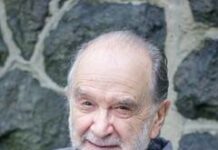
Steve Mendelsohn
I grew up praying to a god in a language I did not understand. In particular, as an observant Conservative Jewish American (that is, “Conservative Jewish, not “conservative, Jewish”), I grew up chanting prayers to the God of Abraham, Isaac and Jacob, who nowadays is also the God of Sarah, Rebecca, Rachel and Leah, in Hebrew. (Chanting is much like singing, only the songs are prayers.)
As a child going to Hebrew school three times a week and religious services once or twice a week (i.e., Friday night and/or Saturday morning), I learned how to read Hebrew. When I say that I learned how to read Hebrew, I mean that I learned how to pronounce words that were written in the Hebrew alphabet. I do not mean that I understood the meaning of those words.
The prayer book had the prayers in Hebrew on the right-hand pages and the English-language translations of those same prayers on the corresponding left-hand pages. It is possible that, every once in a while, I looked to the left to see what the meaning was of the prayers that I was chanting in Hebrew along with my fellow congregants, but, if that ever happened, it was a rare occurrence. Instead, like most of my fellow congregants, I simply continued to chant those prayers in Hebrew without ever knowing what they meant.
The most important Jewish prayer in the Hebrew liturgy is The Shema, which is also probably the shortest Jewish prayer in the Hebrew liturgy. (One might think that, if the most important Jewish prayer in the Hebrew liturgy were also one of the shortest – if not the shortest – prayer, then Jewish religious services would likewise be short. Unfortunately, that was not – and is not – the case.)
Transliterated into the English alphabet, The Shema is:
Shema Yisroel, Adonai Eloheinu, Adonai Echod
which is traditionally translated into English as:
Hear, O Israel: the Lord our God, the Lord is One
(Technically, that is only the opening line of The Shema. The Shema actually goes on for another four paragraphs, which helps to explain why Jewish religious services are not so short after all.)
According to Reuven Kimelman, a world-renowned expert in Hebrew liturgy and a professor of classical rabbinic literature at Brandeis University, whom I “met” during my in-depth (i.e., Google) research on the subject, The Shema is the central affirmation of Judaism. The prayer “expresses belief in the singularity of God, that is, in God’s oneness and incomparability.”
Wherever you go in the world, or at least wherever you go in the world where there are Jews praying, you will hear The Shema chanted in its original Hebrew. That means that any Jew who grew up learning to chant The Shema in Hebrew can go to any synagogue anywhere else in the world and chant The Shema along with the other congregants no matter what other language they may speak the rest of the day.
For example, when I was backpacking through Europe in 1982 after finishing graduate school, I went to the famous copper-domed Great Synagogue in Florence, Italy, for Friday night services. I was led to believe that, if I got there early enough, some kind family would invite me to their home for dinner after services. If I had not gotten terribly lost (in those ancient days before GPS), I am sure that I would have gotten there in time to chant The Shema in Hebrew with the rest of the congregants and then had a delicious kosher Italian meal. As it was, by the time I found the place, services were just ending, I missed The Shema, and no one invited me home for dinner. But I hope you get the point anyway.
The point is that chanting the same prayers in the same language helps to unify the Jewish people. It is estimated (i.e., further intense Google research) that, in a world filled with more than 7.888 billion people, there are only about 16 million (i.e., 0.016 billion) Jews.
When you are part of a minority that makes up about 0.2% of the world’s population, being unified can be important, especially in a world in which too many of the remaining 99.8% don’t like us very much. For those of us who believe that it is a good thing for the Jewish people to be unified, chanting The Shema in Hebrew should be important.
Ronald Brauner, one of my favorite teachers ever, taught me that it is more important to pray in Hebrew than to understand the meaning of those prayers. The best is both chanting and understanding, but, given only one, for the sake of Jewish unity, it is better to chant Jewish prayers in the original Hebrew – even if you do not understand what you are saying – than to chant prayers in their translated English.
As I was growing up praying to God in Hebrew in the 1960s and 1970s, I believed that “He” existed. Over the last five decades or so, my belief in “His” existence has slowly but inexorably waned such that, today, I am a devout atheist who believes that no God exists. Not the God of Abraham, Isaac, Jacob, Sarah, Rebecca, Rachel, and Leah. And not the God of anyone else either.
(A few years ago, a fellow Jewish atheist friend of mine asked me what one who does not believe in the existence of God should do about saying the Kaddish, the Jewish prayer of mourning for dead relatives, which ironically says nothing about death or dying, but is instead filled with praise of God. I told her that, in that case, it is important to pray in a language that you don’t understand.)
A few years ago, in an attempt to find meaning during Yom Kippur, which, along with Rosh Hashanah, is the most important Jewish holiday (i.e., as in “holy day, not as in “a day off from work”), my wife and I and our two children went with friends to their “folkshul” service, which is appropriately and yet somewhat ironically held at a local Quaker meetinghouse. (Today, to find meaning during Yom Kippur, I am writing this essay.) As best I can tell (from more, diligent Google searching), folkshul is Yiddish for “peoples’ shelter.” What it really is is a movement of secular humanist (i.e., my fellow atheist) Jews. As their website explains:
We welcome all who want to be part of our Jewish community including, but not limited to folks who are: culturally Jewish, agnostic, atheist, spiritual, self-identified Jewish, Jew~ish, Jew-curious, in an interfaith family, LGBTQ, leaving Judaism, returning to Judaism, freethinkers, humanists, grandparents, singles, couples, parents-trying-to-give-their-kids-good-values-and-a-cultural-identity-in-a-non-religious-setting …
I enjoyed the Yom Kippur service very much except for one thing. OK, two things. You’d think that the “religious” service of a group of atheist Jews would be short. Well, you’d be wrong. Actually, that was just a joke. The folkshul service was not that long and certainly not as long as traditional Yom Kippur services, which go on and on and on.
The one thing that did actually bother me about the folkshul service was that it changed the Hebrew of The Shema. I didn’t mind that the English translation of The Shema was replaced by a version that did not mention God, but I did mind that they changed the Hebrew version of The Shema.
As a result, the kids of those “parents-trying-to-give-their-kids-good-values-and-a-cultural-identity-in-a-non-religious-setting” are being raised to learn a version of The Shema in Hebrew that is different from the version of The Shema in Hebrew learned by the rest of us Jews.
As such, when those kids go backpacking through Europe after finishing graduate school and use their GPS-enabled cell phones to find the Great Synagogue in Florence, Italy, on a Friday evening, they will not be able to chant The Shema with the rest of the congregants, whether or not any of those congregants invite them home for dinner. And that is not good for Jewish unity.
Steve Mendelsohn is the founder of Mendelsohn Dunleavy, P.C. He can be reached at [email protected].






